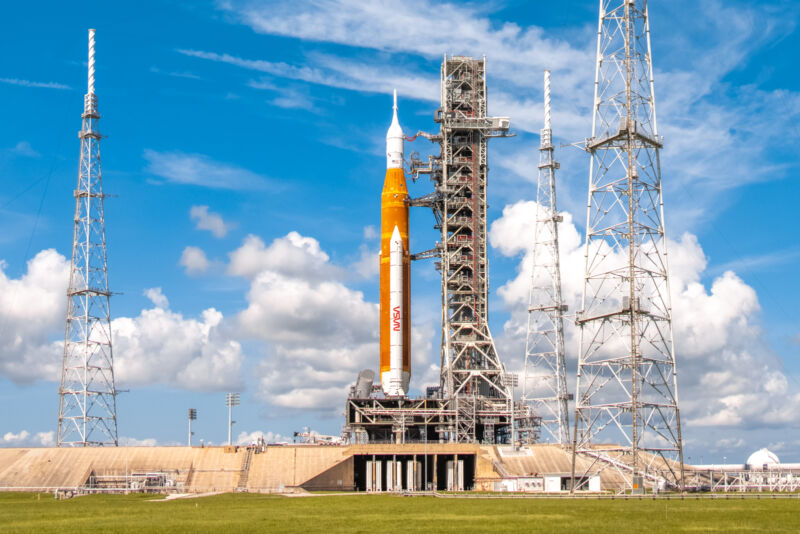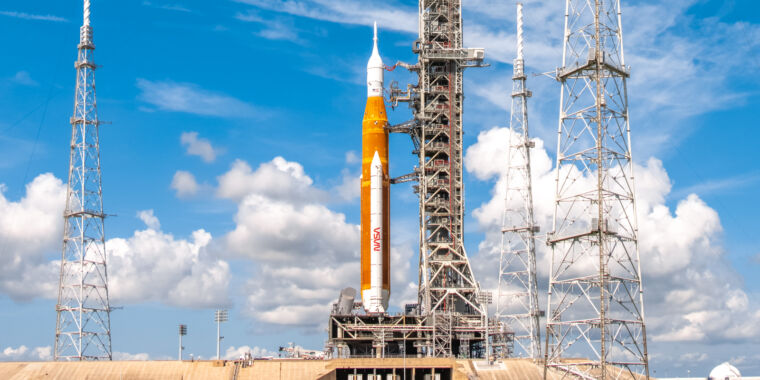Savage Launch System —
“If we didn’t design it to be out there in harsh weather we picked the wrong launch spot.”

Enlarge / NASA’s Space Launch System rocket at LC-39B on September 1, 2022.
Trevor Mahlmann
NASA said on Friday that its Space Launch System rocket and Orion spacecraft appear to have survived their encounter with Hurricane Nicole this week without incurring any significant damage.
“Right now there’s nothing preventing us from getting to the 16th,” said Jim Free, the engineer who leads the development of exploration systems for NASA. To that end, the space agency is working toward a launch at 1:04 am ET (06:04 UTC) on Wednesday, from Kennedy Space Center. This Artemis I mission will send an uncrewed Orion spacecraft around the Moon in preparation for human missions later this decade.
Free said Nicole produced significant winds over the spaceport in Florida. However, he did not provide precise numbers, nor exact design specifications that the Space Launch System rocket is designed to withstand. However, Free said that at no point was the rocket exposed to wind gusts above its design limits. This appears to check out, based on publicly available data. For example, the National Weather Service reported a maximum wind gust of 93 mph at an altitude of 200 feet at the rocket’s launch pad, which is close to, but not above, the rocket’s limit of 97 mph at that height (see full SLS design specifications for weather).
A preliminary inspection of the rocket on Thursday night and Friday night after the storm had passed revealed only some very minor issues, most of which had already been addressed by Friday afternoon when Free spoke to reporters during a teleconference. “We design it to be out there,” Free said of the rocket, noting Kennedy Space Center’s exposure to hurricanes on Florida’s Atlantic coast. “If we didn’t design it to be out there in harsh weather, we picked the wrong launch spot.”
Even so, NASA did not leave its rocket exposed to Nicole’s fury on Thursday by choice. The rocket’s engineering teams engaged in long meetings last Sunday, as it was becoming clear that Nicole posed a serious threat. If they had made the decision to roll the Artemis I stack back inside the protective Vehicle Assembly Building at that time, the operation would not have been complete until Wednesday.
By then, it was too late to roll back safely, as the vehicle risked being caught during the delicate moving operation when Nicole’s winds were rising ahead of its landfall in Florida.
“From our perspective, we stayed within the certification with the winds that we saw during the hurricane,” Free said. “I think it’s safe to say, for all of us, we obviously would not have wanted to stay out there. The best place for the vehicle in those kinds of things is the VAB. But we could not make it back to the VAB and be safe. So we stayed where we were, and our predictions and our certification limits protected us from the storm.”
While NASA inspected the rocket’s exterior, it appears unlikely they will probe the structural integrity of the interior of the vehicle, such as fasteners and other materials prone to wear and fatigue. Free said NASA’s engineers have confidence because the wind loads on the rocket did not exceed their design specifications, which were verified as part of vibration, or modal testing, conducted on the vehicle about a year ago.
The early weather forecast for a launch attempt on the morning of November 16 in Florida is positive. Winds are forecast to be light, with partly to mostly clear skies. If there are technical issues that preclude the launch—this will be the third attempt to launch Artemis I in the last three months—NASA has another opportunity on Saturday, November 19. The agency has a final chance to launch this month on November 25, the day after the Thanksgiving holiday in the US.










